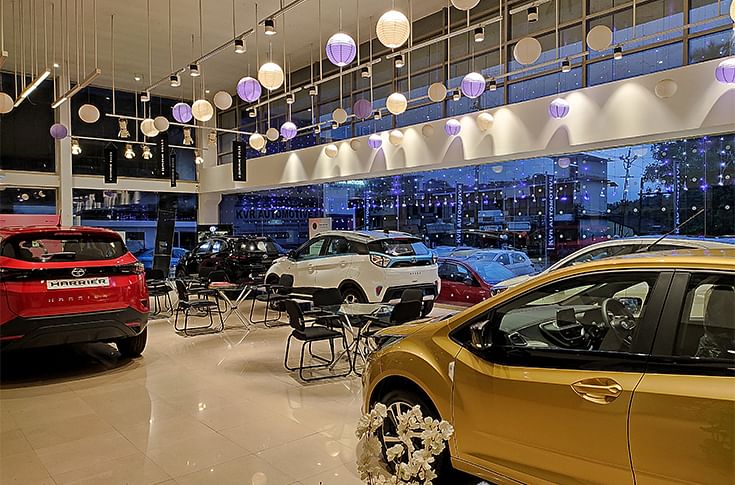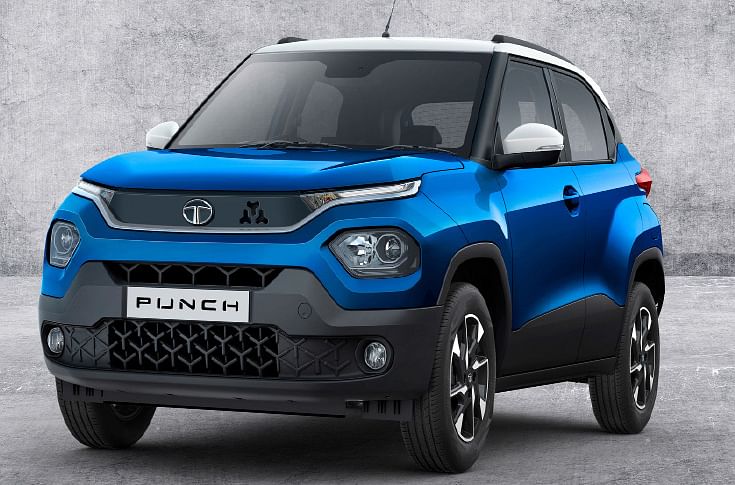Weathering the storm
Tata Motors has been relentlessly focusing on cost reduction initiatives while scouring for alternatives to tide over the chip shortage crisis. Shailesh Chandra, President, Passenger Vehicles Business Unit, discusses this and a lot more.
Shailesh Chandra admits that the world has not seen this kind of volatility in recent times. “Everything is happening all at one time and it is like batting on a very unpredictable wicket…but you still need to bat,” says the President, Passenger Vehicles Business Unit, Tata Motors. It is an apt analogy at a time when cricket is the flavour of the season even though India has been getting the rough end of the stick during the ongoing T20 World Cup.
Beyond Covid-19, the auto industry has been up against other headwinds like rising input costs, shortage of semiconductors and a potential energy crisis which is seeing crude prices spin out of control coupled with a shortage of coal and magnesium.
Chandra, however, chooses to look at the brighter side of things. “Crises also can create opportunities,” he says while citing the instance of steep commodity prices and their ability to erode bottomline. This is where Tata Motors’ efforts to go in for “immense cost reduction measures” have paid off rich dividends.
“This is a permanent structural change which we have created and it has really helped us in these challenging times. It has shown that you can weather the storm especially during this period,” says Chandra. The cost-cutting drive is across functions involving thousands of employees and cross-functional teams. It is expected to “go a long way” in keeping the edifice strong and will continue even in good times.
The chip shortage is an issue that could linger for a year longer but the silver lining here is the occurrence of “two major events” in the first and second quarters of this fiscal which aggravated the situation. One was the fire at Renesas Electronics Corp, a Japanese-based semiconductor plant, that impacted Q1 but was not felt so acutely in India because of the deadly second wave that snuffed out thousands of lives. Meanwhile, Q2 saw Malaysia hit by the Covid-19 outbreak which affected supply of semiconductors worldwide.
Even while these were serious setbacks, there was a big positive in terms of Tata Motors trying to find its own way “to absorb the shock by taking different actions”. As Chandra elaborates, there are “certain unique things we are trying to do” and tide over the crisis to the best extent possible.
“We are finding alternative ways of how we can avoid loss of scale and there are a few things we have been doing,” he says while steering clear of specifics. There have been “better conversations” happening with semiconductor suppliers as well as those in the Tier 1/2 level.
Additionally, efforts are on to scout for more standard chips instead of specialised ones. “We have to work like this for a while now till the crisis eases off,” says Chandra.
Making the charge in India’s EV market

It is but natural that the conversation veers around to electric vehicles where Tata Motors has left no stone unturned to keep itself ahead of the curve. The Nexon EV and Tigor EV are already out in the market while the recently launched Punch micro SUV could also have an electric sibling in due course of time.
“Electric has played a big role (for us) and when we come with EVs, they are equally safe too. Whatever leadership position we have taken in this space along with the commitment — whether it is development of the ecosystem or bringing the value addition to India — everything is being appreciated,” says a visibly pleased Chandra.
It has not been easy going for sure since a transition to electric also means that the requirements relating to “capabilities and competencies also change a lot”. While acknowledging the efforts of those who helped create a “great knowledge pool” within the organisation, he says that the “jump into electric” has played a big role in building competencies since this was a completely new foray.
“The more issues we encountered, there were more lessons to be learnt which in turn kept enhancing our understanding of the technology better. It also helped in identifying opportunities and filling gaps where we needed to build competencies,” adds Chandra. It was an added bonus to access the skills of the group company, Jaguar Land Rover, and seek support during this transition.
“We were hungry to learn and wanted to experiment more and more. The journey still continues since we haven't attained maturity yet and there is still a long distance to cover while building competencies in electric. We remain committed to it,” he reiterates.
Electric will coexist with the internal combustion engine (ICE) for some years now since the transition in India is still a gradual process and expected to continue into an early part of the following decade. To that extent, mechanical systems, suspensions and body engineering are as critical as electric and electronic systems.
Clearly, the new competency areas need to be built and “anybody who is a serious learner and ready to do new things while taking risks and obsessed with bringing change” qualifies to be part of this makeover. Typically, the journey will involve a generation of engineers “that you need before you go to the generation of entrepreneurs you need” in order to be able to leapfrog into new technologies.
Chandra believes that the future will be about creating networks because there are “so many new things and specialisations" which are coming in. “There is an immense need for primary research. This is how the western world has taken the lead by bringing all these networks and integrating them so well to bring new inventions and innovations,” he elaborates.
This is absolutely vital in India too and Tata Motors is also doing its bit by trying to tie up with some academic institutes which “also have the same hunger” of getting into this arena. “At the same time, we must work with different start-ups in small areas which can really ensure higher maturity of our product and create a different ecosystem,” continues Chandra.
Talks are underway with start-ups working on certain breakthrough technologies. By the end of the day, it is imperative for companies to come out of the silo mode which they have been used to for so long and operate like a network within the ecosystem.
Clearly, the change will be massive and not an easy one to contemplate by any stretch of imagination. After all, there is already a big ecosystem working on ICE and electric likewise will need the birth of a network and supply/value chain. “You cannot change a lot of things at the drop of a hat…this is going to be a gradual shift that will take time when companies replace one ecosystem with another,” says Chandra.
The entire value chain has to gear up to that kind of capacity — the truth is that the size of the global car market is 100 million units annually of which EVs account for merely three million. “You also need to create talent for these new competency areas which cannot happen overnight. Different economies have to make sure that employment which was within that ecosystem is not made irrelevant,” he says.
In the Indian context too, the shift to electric will be gradual even while there seems to be a greater sense of urgency right now thanks largely to the generous sops provided both by FAME 2 and various States along with a lower GST levy of five percent (compared to 28 percent for ICE cars).
“In the next 3-4 years, you will see a more noticeable adoption,” says Chandra while driving home the point that penetration levels of cars in India are in any case still low. This only means that growth will happen faster than developed countries simply because of the huge potential.
“This growth will come on the back of EVs even when they reach penetration levels in high single digits. You will still see growth of ICE vehicles but not like those you have (seen) in the past,” he says. Diesel could also face “the highest pressure” in terms of relevance which is already being borne out by its diminishing market share vis-a-vis petrol.
Pleased as Punch

For now, Chandra is upbeat about the Punch which has the potential to clock good numbers and strengthen its manufacturer’s position as the third largest player after Maruti and Hyundai. The new set of car buyers is also younger and today the age group of under 35 years account for nearly 65 percent of sales. “Cars are being seen as objects of self-expression and people choose them to suit their personalities,” he says.
This is where SUVs are being sought after with youngsters aspiring to own them. “This age group is looking for affordable cars since they have started early in their work lives and are keen to establish themselves. They would like to go for cars which are aspirational and yet affordable so the Punch fits in well with this requirement,” says Chandra.
Beyond age, the gender balance is also changing with more and more women buying cars, quite unlike the not-so-distant past when this decision was left to their fathers or husbands.
“I see three clear trends happening and it is vital for manufacturers like us to connect with them to move up in terms of brand aspiration perception,” he says. These “mega trends” centre around environment, safety and self expression. Customers always want to connect with things that express their personalities/values which only reaffirms the importance of design.
“We also offer the safest cars and are leaders for the most environment-friendly models that connect with technology,” says Chandra. The concoction is working well so far and Tata Motors will be hoping that Punch powers the growth story.
This feature was first published in Autocar Professional's November 1 issue.
RELATED ARTICLES
From Rs 431 Crore Loss to Recovery: Inside TIL’s Comeback
New ownership charts ambitious turnaround for TIL, India's oldest crane manufacturer.
Why Toyota Is Building Its Carbon-Neutral Future Around India
A look inside the engineering logic driving the world’s largest carmaker as it pursues multiple routes to decarbonisatio...
ZF’s Construction Equipment Strategy Reveals How India Has Moved Beyond the Auto Market
ZF's leadership sees the construction equipment sector as an anomaly, a segment that, despite its current sluggishness, ...






 03 Nov 2021
03 Nov 2021
 3367 Views
3367 Views





 Shahkar Abidi
Shahkar Abidi


 Ketan Thakkar
Ketan Thakkar


